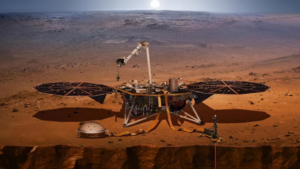Finding a Liquid Reservoir of water deep inside Mars is an incredible Approach to Space exploration. This beyond-belief finding by scientists has the potential to alter our insights into Mars and maybe the course of future human exploration of the planet. The discovery of a sizable underground water reserve under the Martian crust calls fascinating questions about the past, present, and future of the planet and its capacity to harbor life.
Martian water discovery can lead to several more discoveries and aims for its explorations. The researchers have shown that a significant volume of liquid water exists far below Mars’s surface.
Data from NASA’s Mars Insight Lander, which has been investigating the planet since its 2018 landing, was used to make this Mars water reservoir discovery. Equipment on board the lander was designed to detect vibrations from Marsquakes, which are similar to Earthquakes.

Scientists could determine what materials these vibrations were traveling through by examining the vibrations. This Martian water discovery is comparable to how we search for gas, oil, or water beneath the surface of the Earth. The findings indicated that liquid water reservoirs can be found between 6 and 12 miles (10 and 20 kilometers) underneath Mars’ surface.
This is the first discovery of Mars’s water reservoir. We used to know that there was some water vapor in the sky and frozen water at the poles, but not liquid water like this.
The Martian water discovery is important because it clarifies the disappearance of all the water from Mars. During billions of years, a large portion of the water that formerly filled Mars’ rivers and lakes either fled into space or became buried beneath.
Although this is an exciting discovery, the fact that the water is buried so deep below the surface implies that it would be exceedingly difficult to get. For those who have aspirations of populating Mars, this is significant because access to this water would necessitate digging through miles and miles of rock.
Space exploration has a lot and a lot coming out that could open doors of useful stuff for scientists, researchers, and explorers.
How InSight Made the Groundbreaking Reservoir of Water Discovery

Seismic data from NASA’s InSight lander, which explored Mars from 2018 to 2022, has led researchers to the discovery of a liquid Reservoir of water 7.2–12.4 miles (11.5–20 kilometers) underneath the planet’s surface. This water, which is found in igneous Martian rocks openings, may eventually fill an ocean big enough to encircle Mars.
According to Dr. Vashan Wright, the lead author and a planetary scientist of study at the Scripps Institution of Oceanography at the University of California, San Diego,
“The crust is heated enough at these depths for liquid water to exist. The water would be frozen as ice at shallower levels. The speed of seismic waves and their depth dependence were measured by InSight. The composition of the Martian rocks, the locations of its fractures, and the materials used to fill those fractures all affect the seismic wave’s speed.”

Nonetheless, NASA’s InSight lander was the first robotic mission to explore Mars’ deep interior. It gave scientists a wealth of information over four years, including measurements of seismic waves, which are vibrations that move through the layers of the earth.
Life on Mars once existed, but it is now a cold and isolated desert. The Earth was considerably rainier and warmer over 3 billion years ago, with rivers, lakes, and maybe even oceans on its surface. Where all this water disappeared has long been a mystery to scientists. An important hint is provided by the latest study: a large portion of it might have seeped into the planet’s crust and is now trapped inside broken rocks.
This finding of Mars water reservoir suggests that contrary to what was previously thought, Mars may have preserved a sizable amount of its water underground, similar to Earth.
Although this discovery of the Reservoir of water is exciting, it also poses serious obstacles for operated Mars missions in the future. Drilling through kilometers of rock to get this liquid water would be a challenging and complex task even on Earth, let alone on Mars.

The northern hemisphere of Mars’ Cerberus Fossae region is well-known for its geological activity and could provide easier access to water sources. The necessity to preserve the Martian ecosystem would, however, have to be carefully considered in any exploration or extraction activities like further Martian water discovery.
The finding of a sizable liquid water subterranean reservoir on Mars is revolutionary. It poses both potential and problems for human exploration, in addition to creating new avenues for the hunt for life on Mars.
Any prospective human settlement on Mars must have access to water, so knowing where to find it and how to get there is a vital first step in future planning. This Reservoir of water discovery will surely impact upcoming missions and our overall comprehension of the Red Planet’s past and habitability as scientists continue to explore it.













